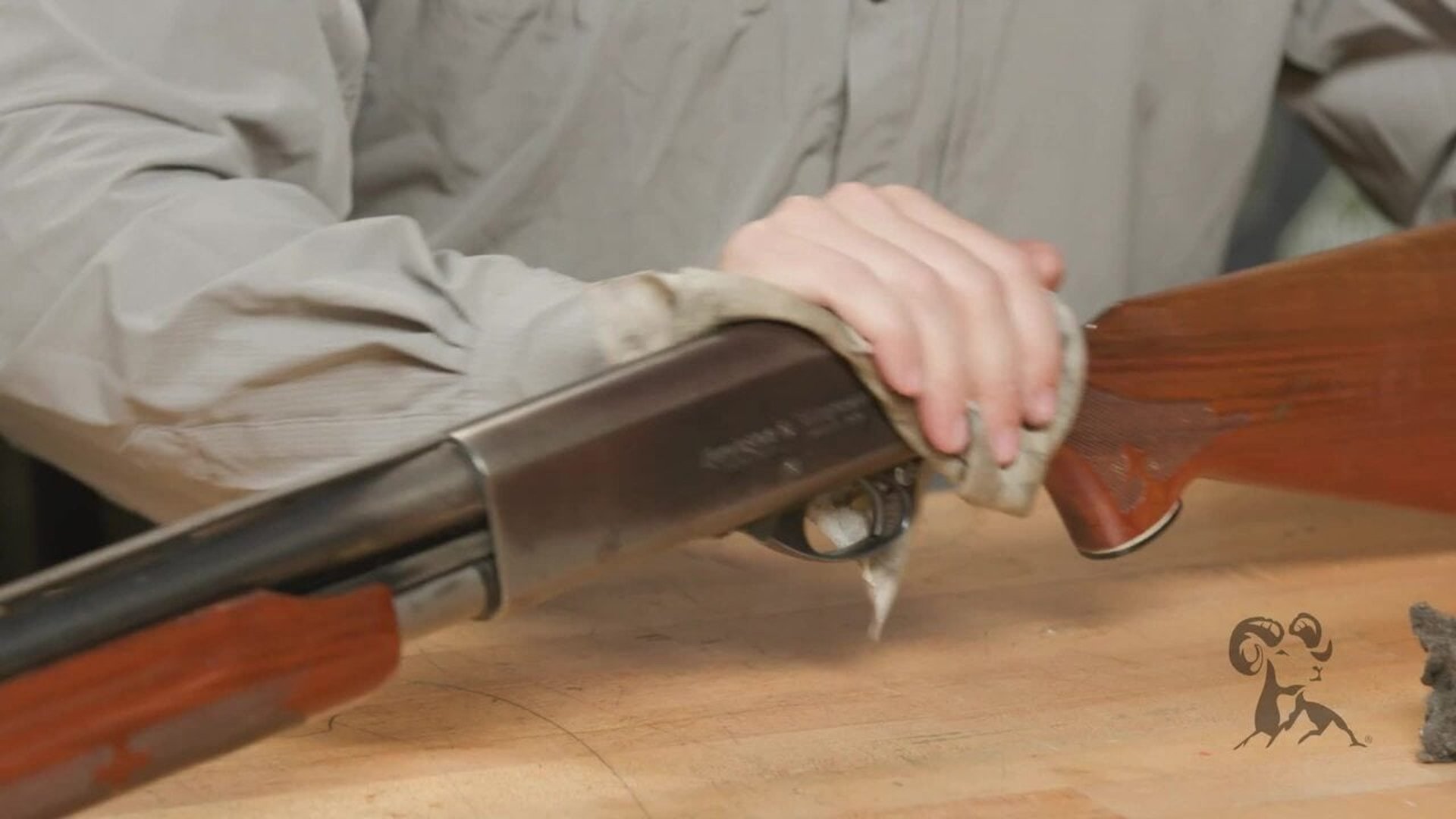Tech Tip: Getting a "New" Old Gun
In this Brownells Tech Tip, Steve and Caleb share a hands-on guide for cleaning and preserving a vintage Remington 870 Wingmaster. This particular shotgun was passed down from Caleb’s father, making it more than just a firearm—it’s a family heirloom full of hunting memories. Instead of refinishing it to look new, they demonstrate how to maintain and protect the original finish, rust patina, and wood character while keeping it ready for future generations.
What You Will Learn
Viewers will learn a step-by-step, hands-on approach to cleaning and preserving a vintage Remington 870 Wingmaster. Removing surface rust, protecting the original bluing and patina, inspecting/tightening the stock, and conditioning the wood—without stripping away the gun’s history. Steve and Caleb show which mild tools and oils to use, and how to store the shotgun to prevent future corrosion.
Benefit
By watching this video, viewers will discover how to preserve their firearm’s history and value by maintaining the original finish and patina instead of refinishing it. They’ll also gain practical, affordable maintenance techniques that keep heirloom guns safe, functional, and ready to pass down to future generations.
The Story Behind the Remington 870 Wingmaster
Caleb begins by explaining the sentimental history of his Remington 870 Wingmaster. The gun was given to him by his father on Father’s Day, and it has been in their family since the 1970s. He recalls countless hunting trips growing up where this shotgun was always part of the adventure. The gun’s smooth action and timeless design make it one of the most iconic shotguns ever produced.
Despite decades of use, the 870 still functions perfectly. The wear on the stock and the polished spots on the receiver tell a story that cannot be replicated. Caleb emphasizes that while it shows signs of age, the gun still smells faintly of the South Louisiana marshes where it was once carried.
When to Refinish and When to Preserve
Many gun owners are tempted to immediately refinish an old firearm when they inherit one. Steve and Caleb caution against this approach. They explain that refinishing removes the natural wear, the bluing patina, and the marks that represent years of use.
Caleb puts it simply: “All that wear and tear was earned.” Every scratch, worn edge, and faded spot has meaning. A complete rebluing or refinish would erase that history. Instead, they recommend cleaning and stabilizing the existing finish to prevent further rust or damage while keeping the gun’s unique character intact.
What Is Acceptable Maintenance for Old Guns
So what should you do when you receive an older firearm? Caleb recommends starting with a gentle cleaning rather than a full restoration. Remove any active rust, wipe down the metal with a light oil, and clean the wood without sanding or refinishing.
The key is preservation, not transformation. Using mild cleaners, oils, and fine materials like 0000 steel wool or bronze wool will safely remove rust without stripping away the finish. This method maintains both functionality and sentimental value.
Cleaning Surface Rust Without Removing Finish
Caleb demonstrates how to clean surface rust on the Wingmaster’s receiver and barrel. He begins by applying a small amount of Rem Oil, which works as both a lubricant and a cleaning agent. The oil loosens grime and rust while providing a protective film.
For tougher spots, he uses fine-grade steel wool (0000) to lightly scrub the surface. This removes oxidation without scratching the bluing. Steve adds that bronze wool or even an old copper penny (pre-1982 solid copper coins) can also be used for delicate cleaning because these metals are softer than steel.
The goal is to remove the active rust while preserving the blued finish and the natural patina that has developed over decades.
Using Oil, Steel Wool, and Bronze Wool
As Caleb works, he explains that these simple materials can make an enormous difference. Rem Oil, Hoppe’s No. 9, or similar gun oils all work well for dissolving surface rust. A soft cloth helps spread the oil evenly and lifts grime from the surface.
When cleaning, it’s important not to use coarse abrasives or high-pressure tools that can damage the metal. Gentle, circular motions with light pressure and plenty of oil will gradually lift rust without removing the bluing underneath.
How to Protect the Receiver and Barrel
Once the rust is gone, Caleb wipes the receiver and barrel with a clean rag to remove residue. He points out that any exposed steel where the bluing has worn away should be kept lightly oiled to prevent future corrosion.
If the gun has deep wear or areas where the bare metal shines through, you can apply a small touch of cold bluing compound to blend it in. However, Caleb chooses to leave the wear marks visible, as they tell the story of the rifle’s decades of use in the field.
Keeping the Character and Patina Intact
Caleb shows how the cleaned metal retains its dark patina and personality. The marks where his father’s hand rested on the receiver have been polished smooth by years of handling. These spots serve as a living memory of how the gun was used and cared for.
He explains that preserving this kind of wear is more meaningful than restoring a “like-new” finish. The balance of the rifle and the worn texture of the checkering are what make the firearm a family keepsake rather than just a tool.
Wood Stock Inspection and Crack Repair Tips
Next, Caleb turns his attention to the wood stock. The stock on this 870 is still in good shape but has a small hairline crack near the tang. He explains that this kind of split often happens when a shotgun is fired while the stock bolt is loose.
Before applying any finishes or oils, it’s important to check for looseness. Hold the receiver in one hand and the stock in the other, then gently twist to feel for movement. If the stock wiggles, tighten the bolt or consult a gunsmith. A tight stock prevents further cracking.
Tightening the Stock and Checking for Damage
If you discover looseness, use a screwdriver or long extension tool to snug the stock bolt carefully. Avoid overtightening, which can split the wood. Once the stock is solid, wipe it down with a clean, dry cloth to remove dust and residue.
Caleb also reminds viewers to inspect the buttplate and sling swivel studs for cracks or loosened screws, as these small details can affect both safety and longevity.
Protecting Bare Metal and Applying Oil
After cleaning and inspection, it’s time to protect the bare metal. Caleb applies a thin coat of Rem Oil to all steel surfaces, including the receiver, barrel, and exposed edges. This step prevents oxidation and keeps the finish from deteriorating.
He emphasizes that a light coat of oil goes a long way. The goal is to leave a protective film without making the surface greasy. Proper maintenance keeps the firearm looking sharp and ensures it remains functional for years to come.
Cleaning and Conditioning the Wood
To clean the wood, Caleb uses a furniture-grade wood cleaner. These cleaners remove dirt and oil buildup without stripping the finish. For most hunting shotguns, the original varnish or oil finish is enough to protect the wood.
He recommends avoiding harsh solvents or refinishing products, which can remove the original factory coating. The idea is to clean and preserve, not refinish or alter the appearance.
Using Linseed or Tung Oil for Shine and Protection
Once the wood is clean, Caleb applies a small amount of hand-rubbed tung oil with a soft cloth. This restores the natural luster of the stock and adds a layer of protection against moisture. Tung oil soaks into the grain and revitalizes old wood without changing its color or sheen.
He prefers hand-rubbed oils over spray finishes because they are more forgiving and easier to control. After applying a thin coat, Caleb wipes off the excess and lets the stock dry before handling.
The result is a warm, satin finish that highlights the wood grain and enhances the gun’s overall look while maintaining its vintage character.
Final Steps and Storage Recommendations
After cleaning both the metal and wood, Caleb gives the shotgun one final wipe-down and checks that all moving parts are lubricated and smooth. He advises storing the firearm in a cool, dry place with a silicone-treated gun sock to prevent rust and moisture damage.
Finally, Caleb reminds viewers that restoring a family heirloom firearm isn’t about making it look new—it’s about preserving its story. Every mark and scratch tells part of that history. By maintaining the finish and protecting the wood and steel, you can ensure your family’s shotgun will continue to serve for generations to come.







